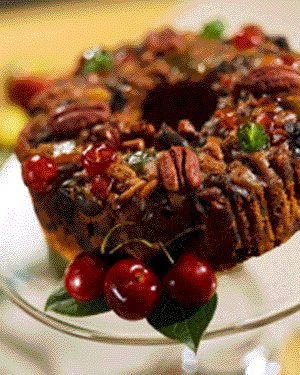Christmas Crumbs

(From Ray:)
How some of our holiday traditions found their place among the festivities of Christmas…
Wrapping Paper
Wrapping paper, though not a new idea, was only commercialized in this century with the advent of cheap color printing. In Victorian times, people had to be creative. Starting simply with brown paper, they would glue on decorative pictures clippings or dried flowers, and would handwrite greetings to the gift's recipient. A spangle or a glossy ribbon would complete the personal touch. Toward the end of the 1800s, colored borders and cut-outs of Christmas motifs were produced for sale, marking the beginning of the holiday gift-wrapping business.
Saint Nicholas
Centuries ago in Asia Minor (present-day Turkey), a boy named Nicholas loved the story of the Magi, the wise men who traveled from afar to bring gifts to baby Jesus. He admired that they came and left with no fanfare. Years later, after Nicholas became a priest, he showed the same humility by quietly distributing food and gifts among the poor. Soon, however, he became known for his deeds. Yet this didn't affect Saint Nicholas, who continued to serve the poor until his death in the fourth century.
Boughs of Holly
Why do we deck the halls with boughs of holly? The small tree with decorative leaves and brilliant berries symbolizes peace and joy, and because it's an evergreen, it is associated with everlasting life. But most of the holly's symbolism relates to Christ's crucifixion rather than to His birth. Its sharp, pointy leaves represent the crown of thorns placed on Jesus' head by Roman soldiers. Its bright red berries stand for the drops of blood He shed on the cross.
Charles Dickens' A Christmas Carol
At a school in London's slums in 1843, Charles saw a swarm of faces--children young in years but in nothing else. He knew the look. As a 12-year-old, he had been forced to work in a shoe dye factory while his father served time in a debtors' prison. This dark spot in Charles' childhood led him to engage in social activism. And it inspired him to write a story about a mean miser, a goose dinner and a little boy with a crutch. His potent tale was an instant success. On the day of its release, 6,000 copies were sold. A century and a half later, its influence hasn't waned. Many a Scrooge-like attitude has been transformed by the power of Charles' Dickens', A Christmas Carol.
Christmas Lights
On New Year's Eve 1879, Thomas Edison unveiled his most famous invention--the light bulb. Only three years later, electric bulbs bedecked a Christmas tree for the first time in the house of the Edison Electric company president.
Boxing Day
"Raps at the door and pulls at the bells," reported an English newspaper in 1841, "averaging one shilling per knock and ring." Such was the custom on the day after Christmas. Bellmen, street sweepers and postmen went door to door to call on their customers. Reciting a poem or offering a printed verse on fancy paper, they collected tips in a box. At the end of the day, the money was used to augment the year's slender wages. Now called Boxing Day, December 26 is an official holiday in many Commonwealth countries today.
Silent Night
In 1816, an Austrian priest penned a simple poem about Jesus' birth. His church organist set these words to music. Together, they premiered their song in 1818 at a Christmas Eve service. Soon after, they parted ways. The fruit of their collaboration would have been lost forever had an organ restorer not discovered the song's manuscript in the church loft in 1825. Today, Joseph Mohr and Franz Gruber's Silent Night is one of the world's most treasured Christmas carol.
(From Calum:)
Emails regarding Christmas and New Years in Scotland:
Calum:
Snow is fantastic, though rare enough round these Gulf Coast warmed parts to make it a rarity. I suspect I would get a bit hacked off with it if I suffered as much of it as happens in der US. But my family has always lived pretty near the coast, so snow is a treat. I remember being about eight years old hurtling down my granny's croft on a fertilizer bag, my face chapped by the onrushing air, bouncing and bumping to the shore. Christmas and Scotland are uneasy bedfellows. We didn't go for it until relatively recently, preferring to keep our powder dry for Hogmanay, so many of these traditions - eggnog and whatnot - are unknown to me. Our Christmas will be low key, as usual. Oh, just in case we don't "speak" before, have a wonderful Christmas and an awesome Hogmanay and new year.
k_sra:
I have no idea what a Hogmanay is, but I will do my best to have a good one. Oh, and try some eggnog. With a little rum.
Calum:
Not a hogmanay, Hogmanay. It's just a big piss up, really. Anyway, I am off to source some eggnog and find an impressionable person to try it for me and report back. I am not one to rush into anything, unforwarned.
k_sra:
Are you considered tall and dark enough for first-footing? Do you indeed do that sort of thing? I might have to adopt the tradition? (That last one wasn't a question.)
Calum:
Tall. Check. Dark. Check. Do I do it? Not so much. It still goes on, to a certain extent, up North, where everyone knows (a) each other and (b) who has the whisky. Down here, it's more of a freezing city centre free-for-all snog-athon. It is an excellent tradition. You should arrive with whisky, shortbread and, if you're very very traditional, a lump of coal (or peat) for the fire. You only qualify as a first footer if you are the first to arrive after the bells/midnight.


3 Comments:
k-srara, you take the plum for best blogmas post. For Boxing Day we should all remember to put a penny in the old man's hat (wouldn't want to presume upon my age and situation) if I show up at your door with a lovely verse. You can always get away with an "Oh, this is the USA. Cash yer blippin' Social Security Check, you right old geezer." (Don't know how many times I've used that line.)
If you 'aven't got a penny, then a fistful of fruit cake will do.
"klnnbk:" Gaelic for "Save your haggis, ye muckle bairns; the clans will rise again (some say "the clans will bake again"; yet others claim the meaning to be "clambake."
Words are a mere plaything for me, and Gaelic words are more than words in such regard. I developed the taste during my days on the Firth of Clyde. North side, around Kilcreggan near Roseneath. Experiences such as made me the man I am today. And Loch Lomond is far more beautiful than Loch Ness.
I see that you are a Gaelic devil with the words, el Dabu. Thanks for the award. I shall put the plum on my thumb and eat it in a corner!
Post a Comment
<< Home